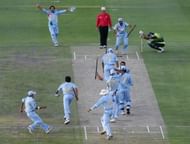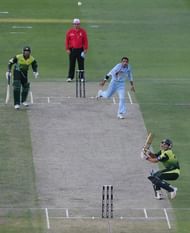The Indian team raises ICC World Twenty20 trophy after defeating Pakistan in the final at the Wanderers Cricket Stadium in Johannesburg, 24 September 2007. (Getty Images)
Circa March 2007. India had just been tossed out of the ICC World Cup by the youthful Bangladesh and the experienced Sri Lankans. A massive backlash by the fans and the general public greeted the players after their Caribbean sojourn ended in heartbreak.
There had even been reports of vandalism; Jharkhand wicketkeeper Mahendra Singh Dhoni’s half-constructed house was damaged by infuriated activists, who held the long-haired cricketer’s poor showing with the bat responsible, in part, for the international debacle.
Greg Chappell, the controversial coach of the side, also came in for heavy criticism from all quarters; he eventually opted not to renew his contract with the BCCI.
Chappell’s constant tinkering with the batting line up, forced Sachin Tendulkar to play in the middle-order. Previous rows with former captain Sourav Ganguly were also considered to be important factors for India’s unceremonious exit from cricket’s quadrennial showpiece.
Months later, the International Cricket Council (ICC) mooted another world championship for promoting the Twenty20 format. India’s veteran triumvirate of Tendulkar, Ganguly and Rahul Dravid decided to opt out, contending that the shortest version was meant for the younger lot. A new captain was chosen, fresh legs were drafted into the squad and off they went to South Africa.
No one, not even the most ardent Indian fan, believed that this bunch stood a chance. The humiliation suffered in the West Indies hung heavily over the side; the likes of Yuvraj Singh, Robin Uthappa, Virender Sehwag and skipper Dhoni had more than a point to prove.
The entire contingent was looking for redemption.
Gautam Gambhir, the left-handed Delhi opener, revived his cricket career with blistering performances through the tournament. He, along with state-mate Sehwag, gave his side the starts they needed.
Rohit Sharma, in his first outing for the senior team, came good with a couple of fine innings, while Uthappa, under-fire for blowing hot and cold since his ODI debut a year ago, also came good with the bat.
Yuvraj, on his own redemption trail, scorched the stands with an incredible display of power hitting – the six sixes he struck off Stuart Broad still bring smiles to Indian faces. RP Singh and Irfan Pathan too re-discovered their form, while Harbhajan Singh got the zing back in his bag of tricks. Riding on their performances, India stormed into the final against arch-rivals Pakistan.
Over to September 24, 2007. The Bull Ring, as the Wanderers Stadium is known as, was chock-a-bloc with supporters of both teams waving their respective flags and shouting themselves hoarse. The Men in Blue stepped out to make first use of the wicket in conditions tailor-made for batting.
Mohammad Asif and Umar Gul, however, had different plans. The all-too-familiar collapse that India had worked so hard to get rid of returned with a vengeance, as the two Pakistani seamers made the ball talk.
Uthappa, Yuvraj and Dhoni fell early without troubling the scorers too much, and the Indian supporters began to fear that their side might once again fall at the final hurdle. Gambhir produced the only innings of note by utilizing his ‘walking down the track’ approach, while Rohit’s quick cameo enabled the team to make a decent score.

The Indian team celebrate their win with Misbah-ul-Haq looking on after the Twenty20 Championship Final vs. Pakistan at The Wanderers Stadium on September 24, 2007 in Johannesburg, South Africa. (Getty Images)
Given the batting firepower the neighbours packed, the game was very much in their favour. Trouble’s best friend S. Sreesanth proved to be very wayward, conceding runs in torrents, despite India getting an early breakthrough in the form of Mohammad Hafeez.
However, Irfan Pathan and Haryana all-rounder Joginder Sharma slowed down the scoring, bowling accurately and conceding lesser boundaries while managing to make further in-roads into the opposition line-up.
Just when India smelled victory, with the asking rate crossing the 12-run mark, middle-order mainstay Misbah ul-Haq turned the game on its head with three monstrous sixes off Harbhajan . He dished out the same to Sreesanth, with tail-ender Sohail Tanvir also joining the party, but the Kerala seamer took out the latter despite another expensive over.
By now, Pakistan needed just 13 runs to win and had six balls to do it in. Memories of Javed Miandad’s last-ball six still echoed in the minds of the fans. For a moment, it looked like RP Singh would take the ball, but Dhoni turned to Joginder, selecting him to send down the last six deliveries of a thrilling final.
The move seemed to have backfired; the seamer bowled a wide first up, followed by a dot ball. At each step, Dhoni would run up to Joginder, advising him to keep it simple and calm his nerves.
Despite that, the Haryana all-rounder delivered a full toss on off, which Misbah lofted back over his head for another maximum, almost disdainfully. The equation was down to six runs from four balls. Who would blink first?

Misbah-ul-Haq plays a shot to be caught to give victory to India during the Twenty20 Championship Final vs. Pakistan at The Wanderers Stadium on September 24, 2007 in Johannesburg, South Africa. (Getty Images)
Misbah did. Joginder pitched the next ball on leg, and the right-hander attempted a paddle-scoop over fine leg. Nine times out of ten, that ball would have raced away to the boundary. Every eye turned skywards as it took off. But Sreesanth, lurking around fine leg, managed to keep his focus as he ran back a few steps, before clutching it safely into his hands.
One moment of stunned silence, then the stadium exploded with wild cheers and celebrations. Misbah sat down on the pitch, on his haunches, unable to comprehend that his attempt at being cheeky had just gifted the opposition the win. The Indians were deliriousm but they were mostly relieved as they had washed off the stigma of March’s ignominy in the Caribbean.
Redemption had been achieved.
A beaming Dhoni lifted the inaugural trophy – the first Indian captain to win a World Cup in 24 years.
He would go on to repeat this feat four years later at the Wankhede Stadium in Mumbai during the ODI World Cup.
This win is still considered by some to be a fluke as the team never reached such heights again in this format. Some still say that Misbah crumbled under pressure, and perhaps he did, but he brought his side back into the match only to falter at the very end.
But a win is a win, anyway it comes.
It has been six years to the day since this spectacle was played out in front of our eyes, but in terms of the bigger picture, it carved its place in the glittering annals of cricketing history. Most of the protagonists are enjoying a second wind in their careers, and they will do so for some time.
For now though, it’s time to savour the moment when a bunch of young players triumphed over adversity in their own way.
Brand-new app in a brand-new avatar! Download CricRocket for fast cricket scores, rocket flicks, super notifications and much more! 🚀☄️
